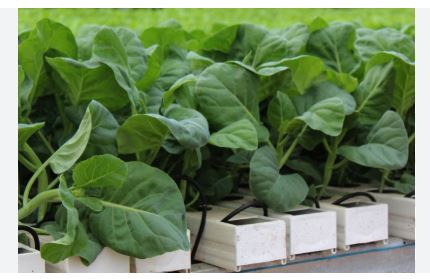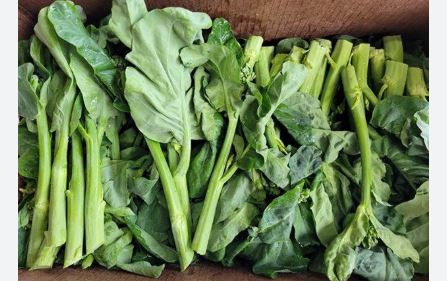
Botanical Classification
Chinese kale, commonly known as gai lan or kai-lan, is scientifically classified as Brassica oleracea var. alboglabra. It belongs to the Brassicaceae family, which includes other cruciferous vegetables such as broccoli, cabbage, and curly kale.
The oleracea species encompasses a wide range of cultivated brassicas, while the alboglabra variety specifically refers to this leafy green, bred for its tender stems, leaves, and flower buds. Gai lan is closely related to broccoli (Brassica oleracea var. italica), sharing similar genetic traits, but is distinct for its focus on edible stalks and minimal floret development.
Origin and History
Gai lan originated in southern China, particularly in Guangdong and Fujian provinces, where it has been cultivated for centuries as a staple in Cantonese cuisine. Its name, meaning “mustard orchid” in Chinese, reflects its brassica lineage and flowering nature. Gai lan spread across Asia through Chinese diaspora communities, becoming integral to Southeast Asian cuisines by the early 20th century.
It was introduced to the United States with Chinese immigration, gaining popularity in Asian American communities and later in mainstream markets during the health food movement of the late 20th and early 21st centuries. Today, it’s grown in states like California and New Jersey, where Asian vegetable demand is high, and is a fixture in U.S. Asian grocery stores and restaurants.
Identifying Characteristics

Gai lan is characterized by its thick, crisp, green stems, glossy dark green leaves, and small, broccoli-like flower buds that bloom into tiny yellow flowers if not harvested. The stems, often 1-2 cm thick, are the primary edible portion, with a succulent, juicy texture. Leaves are broad, slightly wrinkled, and thinner than other kales, growing in a loose, upright cluster rather than a rosette.
The plant typically reaches 12-24 inches tall, with a compact, bushy appearance. Its vibrant green color and sturdy structure make it a standout in markets, distinguishing it from leafier kales popular in the U.S.
Taste
Gai lan has a mild, slightly bitter flavor with a fresh, grassy undertone, less intense than curly kale but more robust than spinach. The stems are crisp and subtly sweet, while the leaves and buds offer a tender, earthy taste with a hint of mustard-like sharpness typical of brassicas.
Cooking, such as blanching or stir-frying, reduces bitterness and enhances its natural sweetness, making it a favorite in quick-cooked dishes. When young, gai lan is tender enough for raw use, though it’s typically cooked in American Asian cuisine to highlight its succulent texture and balanced flavor.
Seasons/Availability
Gai lan is a cool-season crop, thriving in temperatures between 15-24°C (60-75°F), though it tolerates mild heat better than some kales. In the USA, it’s planted in early spring (February-March) or late summer (July-August), maturing in 40-60 days, and is typically available from late spring (April-May) through early winter (November-December).
It grows well in USDA zones 2-11, with significant production in California, New Jersey, and Florida, where Asian markets drive demand. Peak availability occurs in cooler months, and it’s widely found year-round in U.S. Asian grocery stores, specialty markets, and some supermarkets, sold fresh or occasionally frozen.
Culinary Uses
Gai lan is a cornerstone of Cantonese and Asian American cuisine, prized for its crisp stems and versatility. In the U.S., it’s commonly stir-fried with garlic, ginger, or oyster sauce, preserving its vibrant color and crunch, as seen in Chinese restaurants. Blanching or steaming is popular to soften stems while retaining nutrients, often served with soy sauce or sesame oil.
Gai lan is used in noodle dishes, soups, and dim sum, where its buds and leaves add texture. Young leaves can be added raw to salads, though cooking is preferred to reduce bitterness. Its stems are often separated from leaves during cooking to ensure even texture, making it a staple in quick, flavorful dishes across American Asian communities.
Nutritional Value
Gai lan is a nutrient-dense vegetable, low in calories (about 25-30 per cup cooked) and packed with vitamins, minerals, and antioxidants. It’s an excellent source of vitamins K, A, and C, providing over 100% of daily needs per serving, supporting blood clotting, vision, and immune health.
It contains 2-3 grams of fiber per cup, aiding digestion, and is rich in calcium, iron, and folate for bone health and cell function. Antioxidants like glucosinolates and sulforaphane offer anti-inflammatory and potential cancer-preventive benefits. Gai lan’s high nutrient profile makes it a valuable addition to balanced, plant-based diets.
Cultivation of Chinese Kale (Gai Lan)
- Climate and Season: Gai lan thrives in cool weather, with optimal temperatures between 15-24°C (60-75°F), though it tolerates mild heat better than some kales. In the USA, plant in early spring (February-March) or late summer (July-August) for spring and fall harvests. It grows in USDA zones 2-11, with year-round cultivation in mild areas like coastal California and peak fall harvests in cooler regions like the Northeast.
- Site Selection: Choose a site with full sun (6-8 hours daily) for vigorous growth, though partial shade is acceptable in warmer states like Florida or Texas to reduce heat stress. Ensure good air circulation to minimize fungal diseases, particularly in humid areas like the Southeast.
- Soil Requirements: Prefers fertile, well-drained, loamy soil with a pH of 6.0-7.0. Enrich with organic matter like compost or aged manure. In regions with clay soils (e.g., Midwest) or sandy soils (e.g., Southeast), amend with compost to improve drainage and fertility for succulent stem development.
- Soil Preparation: Loosen soil to 10-12 inches deep, mixing in 2-3 inches of compost or organic matter. Remove rocks and debris to promote root and stem growth. Conduct a soil test through local extension services (e.g., USDA’s NRCS) to confirm pH and nutrient levels, adjusting with lime or sulfur as needed.
- Planting: Sow seeds ¼-½ inch deep, spacing 6-8 inches apart in rows 12-18 inches apart for compact growth. Thin seedlings to 8-12 inches apart to prevent crowding. Transplant seedlings started indoors 4-6 weeks earlier for faster harvests, common in shorter-season areas like New York. Direct sowing works well in milder regions like California.
- Watering: Keep soil consistently moist but not waterlogged, providing 1-1.5 inches of water weekly, adjusting for rainfall. Use drip irrigation, popular in arid states like Arizona, to avoid wetting leaves and reduce disease risk. Mulch to retain moisture, especially in hot, dry regions like the Southwest.
- Fertilization: Apply a balanced fertilizer (e.g., 10-10-10) at planting, followed by a nitrogen-rich fertilizer (e.g., fish emulsion) every 3-4 weeks to promote leafy and stem growth. Avoid over-fertilizing, which can lead to tough stems, particularly in humid areas like the Gulf Coast.
- Mulching: Add a 1-2 inch layer of organic mulch, such as straw or grass clippings, to conserve moisture, suppress weeds, and keep soil cool. This is critical in regions with temperature swings, like the Midwest, or hot summers, like the Southeast, to stabilize soil conditions for young plants.
- Pest Management: Monitor for pests like aphids, cabbage worms, and whiteflies, which target gai lan’s tender leaves and stems. Use floating row covers in organic farms (e.g., California), neem oil, or introduce beneficial insects like ladybugs. Hand-pick caterpillars for small gardens, effective nationwide.
- Disease Control: Prevent fungal diseases like downy mildew and black rot, common in humid regions like the Southeast, by ensuring air circulation and avoiding overhead watering. Rotate crops every 2-3 years, standard in intensive farming states like California, to reduce soil-borne pathogens.
- Harvesting: Harvest gai lan when stems are thick (1-2 cm) and buds are tight, about 40-60 days after planting, cutting 6-8 inches above the base to allow regrowth. Start in late spring (April-May) or fall (September-November), with frequent harvests to maintain tenderness, ideal for U.S. Asian markets.
- Succession Planting: Sow seeds every 1-2 weeks in spring or fall for a continuous supply, a common practice in mild climates like California’s Central Valley. In shorter-season regions like Wisconsin, focus on spring and late summer plantings to maximize harvests before hard freezes.
- Storage and Preservation: Store fresh gai lan at 0-4°C (32-40°F) in a perforated plastic bag in the refrigerator for up to 1-2 weeks, standard for U.S. households. For long-term storage, blanch stems and leaves for 2-3 minutes, cool in ice water, dry thoroughly, and freeze to preserve nutrients. Wash and dry before storing to maintain freshness.